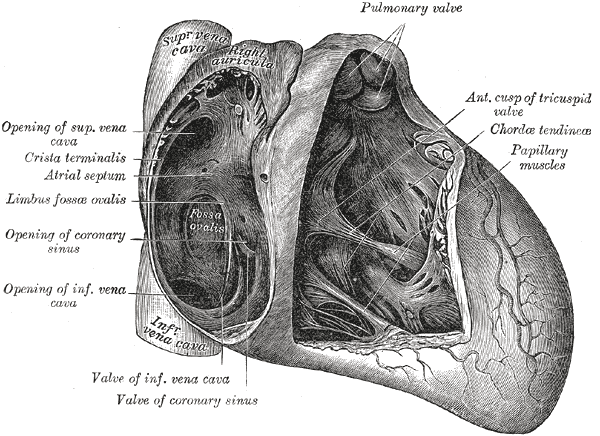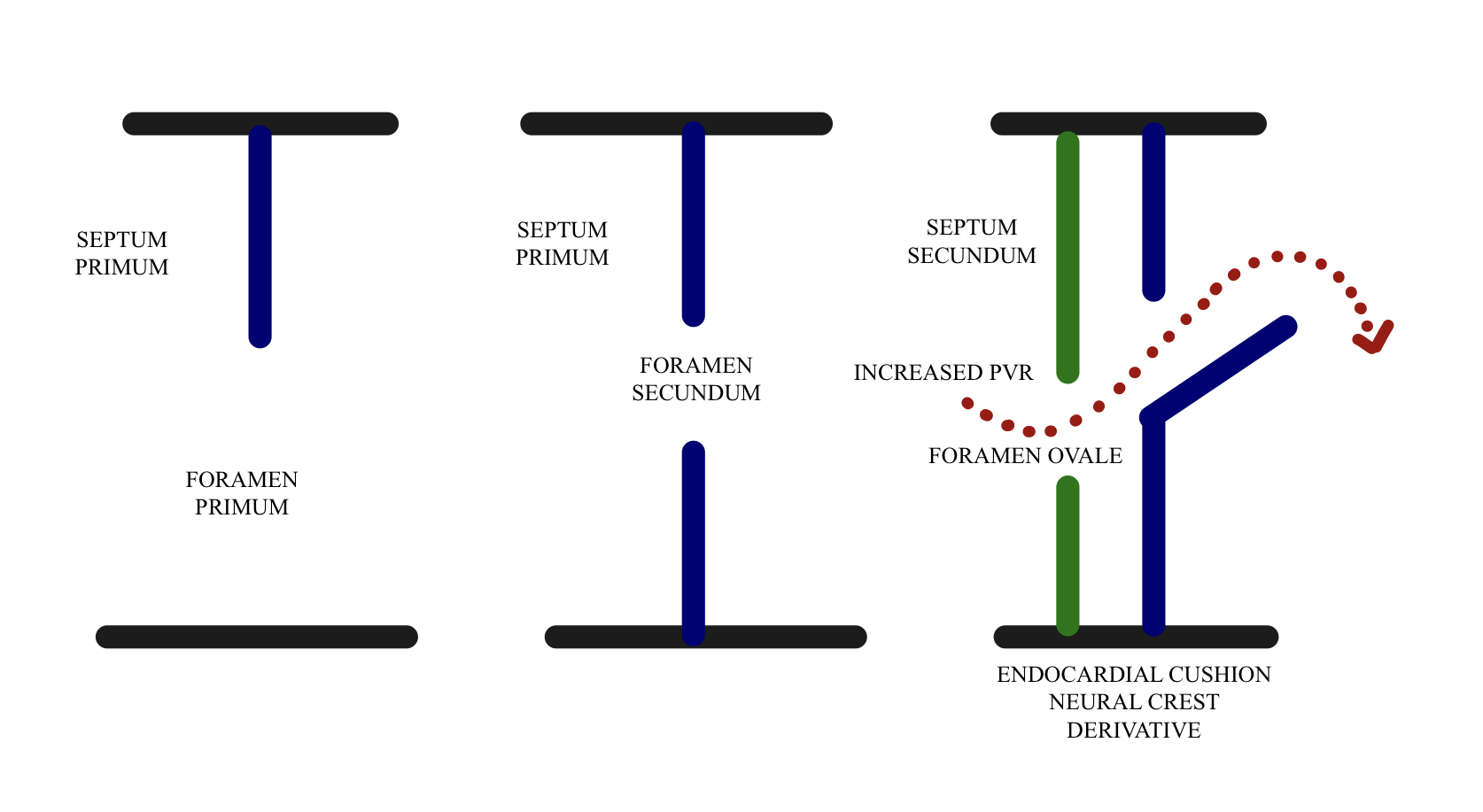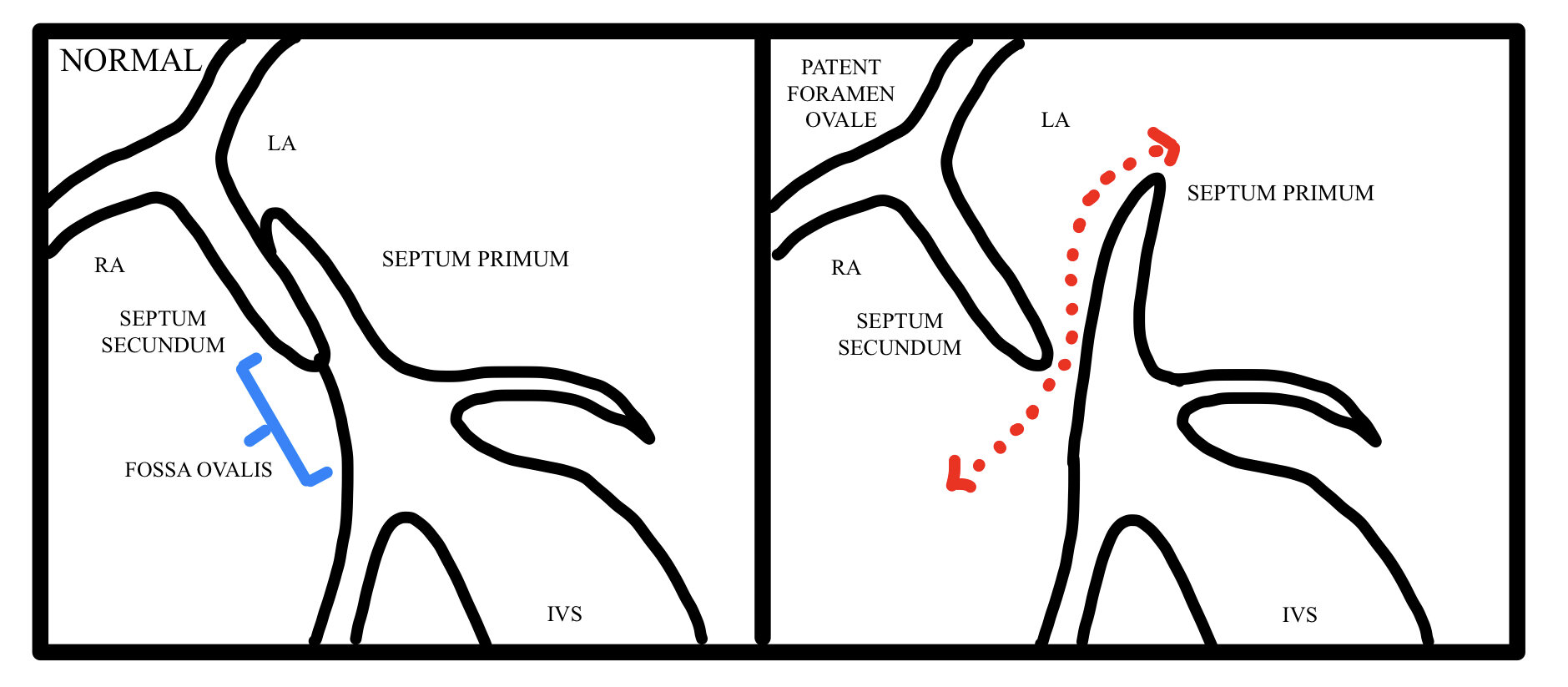[1]
Malik SB, Kwan D, Shah AB, Hsu JY. The right atrium: gateway to the heart--anatomic and pathologic imaging findings. Radiographics : a review publication of the Radiological Society of North America, Inc. 2015 Jan-Feb:35(1):14-31. doi: 10.1148/rg.351130010. Epub
[PubMed PMID: 25590385]
[2]
Joshi SD, Chawre HK, Joshi SS. Morphological study of fossa ovalis and its clinical relevance. Indian heart journal. 2016 Mar-Apr:68(2):147-52. doi: 10.1016/j.ihj.2015.08.001. Epub 2016 Jan 18
[PubMed PMID: 27133322]
[3]
Rana BS, Shapiro LM, McCarthy KP, Ho SY. Three-dimensional imaging of the atrial septum and patent foramen ovale anatomy: defining the morphological phenotypes of patent foramen ovale. European journal of echocardiography : the journal of the Working Group on Echocardiography of the European Society of Cardiology. 2010 Dec:11(10):i19-25. doi: 10.1093/ejechocard/jeq122. Epub
[PubMed PMID: 21078835]
[4]
Barik R. The three-dimensional fossa ovalis. Indian heart journal. 2016 Mar-Apr:68(2):211-2. doi: 10.1016/j.ihj.2016.02.004. Epub 2016 Feb 18
[PubMed PMID: 27133343]
[5]
Shen J. [An application of His bundle electrogram to locate fossa ovalis during percutaneous transseptal balloon valvuloplasty]. Zhonghua xin xue guan bing za zhi. 1991 Jun:19(3):153-4, 197
[PubMed PMID: 1914856]
[6]
Klimek-Piotrowska W, Hołda MK, Koziej M, Piątek K, Hołda J. Anatomy of the true interatrial septum for transseptal access to the left atrium. Annals of anatomy = Anatomischer Anzeiger : official organ of the Anatomische Gesellschaft. 2016 May:205():60-4. doi: 10.1016/j.aanat.2016.01.009. Epub 2016 Feb 12
[PubMed PMID: 26879344]
[7]
Terpenning S, White CS. Imaging pitfalls, normal anatomy, and anatomical variants that can simulate disease on cardiac imaging as demonstrated on multidetector computed tomography. Acta radiologica short reports. 2015 Jan:4(1):2047981614562443. doi: 10.1177/2047981614562443. Epub 2015 Jan 9
[PubMed PMID: 25610617]
[8]
Kanaganayagam GS, Malik IS. Modern management of a patent foramen ovale. JRSM cardiovascular disease. 2012 Oct 31:1(7):. doi: 10.1258/cvd.2012.012017. Epub 2012 Oct 31
[PubMed PMID: 24175077]
[9]
Krupa U. Arterial vascularization of the interatrial septum in the human heart in relation to the type of coronary ramification. Folia morphologica. 1995:54(1):51-9
[PubMed PMID: 8537068]
[10]
Boppana VS, Castaño A, Avula UMR, Yamazaki M, Kalifa J. Atrial Coronary Arteries: Anatomy And Atrial Perfusion Territories. Journal of atrial fibrillation. 2011 Sep-Nov:4(3):375. doi: 10.4022/jafib.375. Epub 2011 Sep 30
[PubMed PMID: 28496703]
[11]
Sokolov VV, Brezhnev FF, Kharlamov EV. [Sources of the vascularization of the human interatrial septum of the heart with different variants of the atrial blood supply]. Arkhiv anatomii, gistologii i embriologii. 1986 Jul:91(7):29-34
[PubMed PMID: 3753224]
[12]
Bohlender JM, Nussberger J, Tevaearai H, Imboden H. Angiotensinergic Innervation of the Human Right Atrium: Implications for Cardiac Reflexes. American journal of hypertension. 2018 Jan 12:31(2):188-196. doi: 10.1093/ajh/hpx163. Epub
[PubMed PMID: 28985343]
[13]
Siddiqui AU, Daimi SR, Gandhi KR, Siddiqui AT, Trivedi S, Sinha MB, Rathore M. Crista terminalis, musculi pectinati, and taenia sagittalis: anatomical observations and applied significance. ISRN anatomy. 2013:2013():803853. doi: 10.5402/2013/803853. Epub 2013 Aug 13
[PubMed PMID: 25938104]
[14]
Hanaoka T, Suyama K, Taguchi A, Shimizu W, Kurita T, Aihara N, Kamakura S. Shifting of puncture site in the fossa ovalis during radiofrequency catheter ablation: intracardiac echocardiography-guided transseptal left heart catheterization. Japanese heart journal. 2003 Sep:44(5):673-80
[PubMed PMID: 14587649]
[15]
Kerut EK, Norfleet WT, Plotnick GD, Giles TD. Patent foramen ovale: a review of associated conditions and the impact of physiological size. Journal of the American College of Cardiology. 2001 Sep:38(3):613-23
[PubMed PMID: 11527606]
[16]
Demir T, Oztunç F, Eroğlu AG, Saltik L, Ahunbay G, Kutluğ S, Güzeltaş A, Altun G. Outcome for patients with isolated atrial septal defects in the oval fossa diagnosed in infancy. Cardiology in the young. 2008 Feb:18(1):75-8. doi: 10.1017/S1047951107001692. Epub 2008 Jan 8
[PubMed PMID: 18179730]
[17]
Azhari N, Shihata MS, Al-Fatani A. Spontaneous closure of atrial septal defects within the oval fossa. Cardiology in the young. 2004 Apr:14(2):148-55
[PubMed PMID: 15691403]
[18]
McMahon CJ, Feltes TF, Fraley JK, Bricker JT, Grifka RG, Tortoriello TA, Blake R, Bezold LI. Natural history of growth of secundum atrial septal defects and implications for transcatheter closure. Heart (British Cardiac Society). 2002 Mar:87(3):256-9
[PubMed PMID: 11847166]
[19]
Chaudhari RG, Shinde SV, Deshpande JR. Morphometric analysis of fossa ovalis in rheumatic heart disease. Indian heart journal. 2005 Nov-Dec:57(6):662-5
[PubMed PMID: 16521634]
[20]
Roberts WC, Ko JM. Some observations on mitral and aortic valve disease. Proceedings (Baylor University. Medical Center). 2008 Jul:21(3):282-99
[PubMed PMID: 18628928]
[21]
Munjewar C, Agrawal R, Sharma S. Cardiac amyloidosis: a report of two cases. Indian heart journal. 2014 Jul-Aug:66(4):473-6. doi: 10.1016/j.ihj.2014.05.028. Epub 2014 Jun 24
[PubMed PMID: 25173210]
Level 3 (low-level) evidence
[22]
Cohen R, Singh G, Mena D, Garcia CA, Loarte P, Mirrer B. Atrial Myxoma: A Case Presentation and Review. Cardiology research. 2012 Feb:3(1):41-44. doi: 10.4021/cr145w. Epub 2012 Jan 20
[PubMed PMID: 28357024]
Level 3 (low-level) evidence
[23]
Onubogu U, West B, Orupabo-Oyan B. Atrial myxoma: a rare cause of hemiplegia in children. Cardiovascular journal of Africa. 2017 Sep/Oct 23:28(5):e1-e3. doi: 10.5830/CVJA-2016-093. Epub 2016 Dec 12
[PubMed PMID: 27942694]
[24]
Acebo E, Val-Bernal JF, Gómez-Román JJ. Prichard's structures of the fossa ovalis are not histogenetically related to cardiac myxoma. Histopathology. 2001 Nov:39(5):529-35
[PubMed PMID: 11737312]
[25]
Val-Bernal JF, Martino M, Mayorga M, Garijo MF. Prichard's structures of the fossa ovalis are age-related phenomena composed of nonreplicating endothelial cells: the cardiac equivalent of cutaneous senile angioma. APMIS : acta pathologica, microbiologica, et immunologica Scandinavica. 2007 Nov:115(11):1234-40
[PubMed PMID: 18092955]
[26]
Edla S, Elsherbiny A, Ravakhah K, Hoit B. Lipomatous Hypertrophy of the Interatrial Septum Presenting with Atrial Arrhythmias. Texas Heart Institute journal. 2015 Aug:42(4):403-4. doi: 10.14503/THIJ-14-4615. Epub 2015 Aug 1
[PubMed PMID: 26413030]
[27]
Xanthopoulos A, Giamouzis G, Alexopoulos N, Kitai T, Triposkiadis F, Skoularigis J. Lipomatous Hypertrophy of the Interatrial Septum: A Case Report and Review of the Literature. CASE (Philadelphia, Pa.). 2017 Oct:1(5):182-189. doi: 10.1016/j.case.2017.06.005. Epub 2017 Aug 23
[PubMed PMID: 30062277]
Level 3 (low-level) evidence
[28]
Ribeiro RNF, Ribeiro BNF, Martins WA, Antunes LO, Marchiori E. Lipomatous hypertrophy of the interatrial septum. Radiologia brasileira. 2018 Mar-Apr:51(2):130-131. doi: 10.1590/0100-3984.2016.0165. Epub
[PubMed PMID: 29743748]
[29]
Topaz O, Edwards JE, Bojack-Mackey S, Titus JL. Aneurysm of fossa ovalis in adults: a pathologic study. Cardiovascular pathology : the official journal of the Society for Cardiovascular Pathology. 2003 Jul-Aug:12(4):219-25
[PubMed PMID: 12826292]
[30]
Katayama H, Mitamura H, Mitani K, Nakagawa S, Ui S, Kimura M. [Incidence of atrial septal aneurysm: echocardiographic and pathologic analysis]. Journal of cardiology. 1990:20(2):411-21
[PubMed PMID: 2104416]
[31]
Ruiz de Larrea C, Lasarte JR, Cuadrado A, Pastor E, Galdeano JM, Cabrera A. [Aneurysm of the atrial septum associated with interatrial communication: a study of 12 cases by 2-dimensional color echocardiography]. Revista espanola de cardiologia. 1993 Jun:46(6):340-3
[PubMed PMID: 8316700]
Level 3 (low-level) evidence
[32]
Mügge A, Daniel WG, Angermann C, Spes C, Khandheria BK, Kronzon I, Freedberg RS, Keren A, Denning K, Engberding R. Atrial septal aneurysm in adult patients. A multicenter study using transthoracic and transesophageal echocardiography. Circulation. 1995 Jun 1:91(11):2785-92
[PubMed PMID: 7758185]
Level 2 (mid-level) evidence
[33]
Ilercil A, Meisner JS, Vijayaraman P, Gentilucci M, Metveyeva P, Hla A, Strom JA, Chang CJ, Shirani J. Clinical significance of fossa ovalis membrane aneurysm in adults with cardioembolic cerebral ischemia. The American journal of cardiology. 1997 Jul 1:80(1):96-8
[PubMed PMID: 9205032]
[34]
Di Pino A, Caruso E, Gitto P. The limbus of the fossa ovalis: an unusual location for incessant focal atrial tachycardia in children. Europace : European pacing, arrhythmias, and cardiac electrophysiology : journal of the working groups on cardiac pacing, arrhythmias, and cardiac cellular electrophysiology of the European Society of Cardiology. 2016 Aug:18(8):1251. doi: 10.1093/europace/euw047. Epub
[PubMed PMID: 27496952]
[35]
Bevilacqua LM, Rhee EK, Epstein MR, Triedman JK. Focal ablation of chaotic atrial rhythm in an infant with cardiomyopathy. Journal of cardiovascular electrophysiology. 2000 May:11(5):577-81
[PubMed PMID: 10826938]
[36]
Cheng TO. The proper conduct of Valsalva maneuver in the detection of patent foramen ovale. Journal of the American College of Cardiology. 2005 Apr 5:45(7):1145-6
[PubMed PMID: 15808778]
[37]
Lam YY, Yu CM, Zhang Q, Yan BP, Yip GW. Enhanced detection of patent foramen ovale by systematic transthoracic saline contrast echocardiography. International journal of cardiology. 2011 Oct 6:152(1):24-7. doi: 10.1016/j.ijcard.2010.06.018. Epub 2010 Jul 8
[PubMed PMID: 20619473]
Level 1 (high-level) evidence




